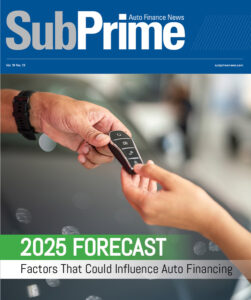How auto finance companies are likely to handle ‘further deterioration’

While also looking closer at the subprime segment as well as credit unions, S&P Global Ratings acknowledged five primary ingredients likely will create “further deterioration” of outstanding auto finance portfolios.
However, firm experts see banks, captives and other providers being able to weather the challenges, according to a report S&P Global Ratings shared with SubPrime Auto Finance News.
First, the elements S&P Global Ratings noted as being the catalysts of portfolio deterioration include:
— High interest rates
— High outstanding balances
— Falling used-vehicle prices
— Consumers’ declining savings
— Likely economic slowdown
“We expect that the entities that will be affected the most are the banks that are most active in auto lending, captive auto finance companies, and nonbank subprime auto lenders. We also think elevated funding costs and tighter funding conditions will eat into profitability and likely limit lenders’ appetites for new originations,” S&P Global Ratings said in the report titled, Auto Lenders Face Headwinds From High Rates And Economic Challenges.
“At the same time, we believe these pressures will generally be manageable for most rated institutions, and we don’t expect negative rating actions to be widespread,” firm experts continued.
S&P Global Ratings elaborated more about the subprime market, reiterating that there are only two providers that analysts officially rate.
“Tougher financing conditions could also weigh on subprime lenders’ origination volume and profitability. Access to funding to support new originations is crucial to auto finance company operations, and funding can be more difficult to access during periods of economic uncertainty or recession,” analysts said in the report.
“The unfavorable debt market conditions we see now, coupled with macroeconomic headwinds, have worsened financing conditions for speculative-grade companies looking to refinance or issue debt,” they continued. “As a result, we expect that these lenders will rely on secured markets to both fund their portfolio growth and address upcoming corporate debt maturities.”
Furthermore, S&P Global Ratings touched on credit unions, which have gained more market share during the past couple of years.
“In 2022, credit unions, which had considerable amounts of cash to deploy, grew their market share significantly in auto lending. That increased competition for loans, and banks and captive lenders saw their market shares in originations shrink,” analysts said. “Data from Experian shows that credit unions’ share fell somewhat in the first half of 2023, although they had the top share in used-car loan originations. Finance companies also grew their share of used car lending in 2022, perhaps as banks slowed their growth, and they continued to take share in the first half of 2023.
“If credit unions exercise more caution in lending, it will ease competition and perhaps reduce the credit risk on future originations. We would expect some of the same funding pressures that banks and nonbanks are experiencing to potentially slow auto loan growth this year at credit unions, as well,” S&P Global Ratings went on to say.

 View The Latest Edition
View The Latest Edition

